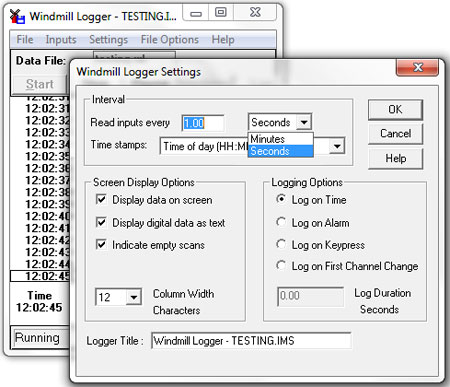Monitor - ISSN 1472-0221
The Newsletter for Data Acquisition and Control
Issue 274 September 2021
Thanks very much for subscribing. You can download a pdf copy of the newsletter here.
Contents
* Fixing fluctuating measurements
* Your DAQ Questions Answered: Downloading the logging software
* Data Acquisition News Round-Up
Fixing fluctuating measurements
Web link: https://www.windmill.co.uk/fixing-fluctuating-measurements.html
Some measurement systems, like those monitoring pH, are very sensitive and prone to interference. Small current or voltage surges can cause large fluctuations in readings.
If you have this problem, here are some simple tests that you can follow to determine the cause of the errors. We've used the Microlink 751 multi-function USB unit as an example but many of the tips also apply other systems. Work through the tests one-by-one, eliminating sources of error as you go.
- Check that the Microlink is working
properly. First remove other factors in the system that
might be causing the problem, then check the
Microlink itself.
- Remove any power signal conditioner. This provides surge protection and noise filtering. It should remove interference from other equipment but a faulty one could cause its own problems.
- Move the Microlink to another location. If you are using it in a laboratory for example, take it home.
- Connect the Microlink to a different laptop running on battery power, not on mains power.
- Now you can test whether the Microlink is the source
of the noisy, fluctuating, data. Connect together
the first positive input pin, the first negative
input pin and the 0 V input pin. With the
Microlink 751 these inputs are on pins 20, 1 and 19.
You could use paperclips to connect the three pins.
Leave all other inputs unconnected.
You have now shorted out the Microlink: if it is working correctly it will produce a reading of zero. If not the fault lies with the unit and you should contact Technical Support and send it back. If the reading is zero then the problem is very unlikely to be caused by the Microlink and you can go on to step 2.

The connections at the back of Microlink 751 data acquisition unit - Once you have eliminated the DAQ unit as the source of the fault, test the power supply to the computer. Plug the laptop into the mains - the reading should still be zero.
- Reconnect any power signal conditioner. Again, check that the reading is zero.
- Test the sensors one-by-one. For example, place a pH probe in a known solution and see if the reading is as expected. Keeping the signal wires short and far away from electrical machinery helps reduce noise. You may also need to clean your electrodes.
- Move everything back to the original location. If the readings become erratic go through the tests again.
- Disconnect from the laptop and connect to the original computer. Again, if you now get noisy readings repeat the tests.
- Finally make your measurements in a real situation.
Discovering at which stage the problem occurs will let you identify the source and take remedial action.
More Information
- Microlink 751 USB System: Measuring pH, Strain, Voltage, Temperature, Current, Counting and Control
- Other questions: just ask
Your Data Acquisition Questions Answered: Downloading the Logging Software
Question
I have been reading your newsletters and using ComDebug for several years but the Logging software looks really useful. Is it possible to download this software? Thank you for your help!

Answer
Yes. Monitor subscribers can download Logger and the other Windmill programs for free. Just email monitor@windmillsoft.com for your copy.
DAQ News Round-up
Welcome to our round-up of the data acquisition and control news. If you would like to receive more timely DAQ news updates then follow us on Twitter - @DataAcquisition - or grab our rss feed.
Tiny sensors to track bugs and combat infestations
Researchers are developing tiny sensors that attach to insects, tracking their movements and life cycles in an effort to combat infestations and increase farm production.
Source: University of Texas Arlington
https://www.uta.edu/
Novel sensor could revolutionise screening for herbicide resistance
Breakthrough study can transform the screening process and enable rapid testing for herbicide resistance in the agricultural industry
Source: Singapore-MIT Alliance for Research and Technologys
https://smart.mit.edu/
New low-cost sensor detects glyphosate in drinks
A newly developed, low-cost sensor can detect and accurately measure the amount of the widely used and controversial herbicide, glyphosate, in droplets of liquid in a laboratory test.
Source: Washington State University
https://news.wsu.edu/
Charging rooms can power devices without wires
New wireless charging technique can scale down to toolboxes, scale up to factories
Source: IEEE Spectrum
https://spectrum.ieee.org/
Satellites and temperature loggers show coral resilience
Researchers use daily satellite data and temperature loggers to examine how each heatwave impacts coral over time.
Source: SCUBA News
https://news.scubatravel.co.uk/
